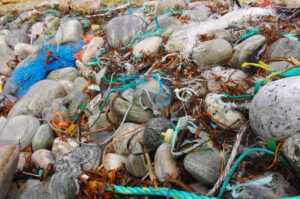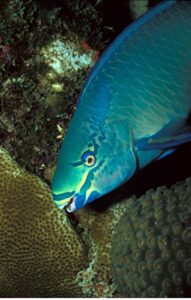[ad_1]
Huang, L., Li, Q.P., Li., H., Lin, L., Xu, X., Yuan, X., Koongolla, J.B., Li, H. (2023). Microplastic contamination in coral reef fishes and its potential risks in the remote Xisha areas of the South China Sea. Marine Pollution Bulletin, 186. https://doi.org/10.1016/j.marpolbul.2022.114399
Microplastics, microplastics everywhere
Nearly everything in our lives has plastic in it. In fact, it’s nearly impossible to avoid (this guy even tried). Even the things you wouldn’t expect contain plastic: Your phone, clothing, pencils, even your doorknob all have plastic in one form or another. It’s well known that plastic debris has made its way into our oceans, mostly as microplastics. Like the name suggests, these are plastic bits that have broken down into tiny pieces that carry toxic pollutants into marine systems. Their size means microplastics are easily ingested by sea animals, posing health complications. A ton is still unknown about their impact on marine life and prevalence across the globe. To address this knowledge gap, a team of researchers measured microplastic contamination in coral reef fishes from remote areas in the South China Sea.

Measuring microplastics in fishes

Coral reef fish of 18 different species were collected from reefs along the northeast Xisha Islands in the South China Sea and taken back to a lab for analysis. To check for the presence of microplastics in each fish, their gastrointestinal tracts and gills were removed and tissue samples were taken. Samples were then placed in a 10% potassium hydroxide solution to dissolve all organic matter. The solution was then filtered, leaving just the microplastics. Individual pieces were counted under a microscope and classified based on their chemical composition, or polymer type. Microplastic abundance was determined as the total number of microplastics contained in each fish. The chemical toxicity of each microplastic was identified based on the polymer hazard index, a method established by researchers in 2011 that ranks polymers according to their potential to cause harm to the environment and human health.
Out of 167 total fish, 49 individuals across 15 different species contained microplastics. That’s nearly a third (29.3%) of all fishes sampled! Among the different species, parrotfish species had the highest occurrence of microplastics at 86.6%, followed by filefish species at 50%, and goatfish species at 43.7%. Emperor fish and sweetlips fish didn’t have any microplastics. Parrotfish are presumed to ingest the most microplastics because of their unique biting style and food preference. Unlike other fish included in the study, parrotfish use their beak-like teeth to bite coral, which are known to accumulate microplastics. Significantly more microplastics were contained in gastrointestinal tracts compared to gills, suggesting that more microplastic is eaten than passively captured by the gills. Nylon, common in fishing gear, comprised 77.3% of the microplastic polymers observed in fishes. Nylon is considered a “high hazard” plastic according to the polymer hazard index.
Significance of findings
The data presented here unearths the widespread nature of microplastics in our oceans, especially the South China Sea. This study provides direct evidence that our actions and litter have far-reaching impact on sea life. It also highlights that certain fish species may be more vulnerable to plastic pollution than others, causing disruptions in species composition and ecosystem health. Although this is an important step in microplastic research, more research is required to determine how pervasive and impactful this problem will be on marine ecosystems as plastic consumption continues.
Cover photo by USFWS Pacific, CC BY-NC 2.0.

I’m an MSc student in marine biology at the University of Hawaiʻi at Mānoa. I conduct research through the Johansen Fish Resilience Lab at the Hawaiʻi Institute of Marine Biology. I’m currently studying the effects of sedimentation on the foraging behavior of herbivorous coral reef fish. Before grad school, I got a double BS in environmental geology and environmental studies at Tufts University before working at a shark research lab in the Bahamas. In my free time, you can find me climbing, running, or reading at the beach.
[ad_2]
Source link

